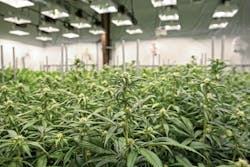A Budding New Industry
In November 2016, voters in the state of California approved Proposition 64, legalizing the recreational use of marijuana. This new legislation allows cultivators to grow their businesses within an established set of regulations governing construction, agriculture and industrial/manufacturing activities. This article discusses the storm water compliance components California project developers and cultivators should consider and account for in the design, construction and operation of their new facilities. While a variety of regulations are in place for protecting the quality of receiving waters from construction, industrial and agricultural runoff, new regulatory language is being developed to specifically address this fast-growing industry.
Planning & Design
During the planning and design phase of any project, it is important to consider the impacts operations will have on the environment. Once a project is green-lit for design, it will be important to understand the post-construction water balance or low impact design (LID) requirements imposed by the municipality and/or state in which the facility will be operating. Areas covered by a Municipal Separate Storm Sewer System (MS4) Permit will need to comply with the MS4's discharge requirements. If operating outside of an area covered by an MS4 and with disturbance of more than 1 acre of land, compliance with the Post-Construction Water Balance Calculations incorporated in the NPDES General Permit for Storm Water Discharges Associated with Construction and Land Disturbance Activities Permit (CGP) is required. The 1-acre-of-land disturbance threshold is an important figure to remember, as it carries additional compliance requirements under the Clean Water Act.
SWPPPs
For projects that will disturb one or more acres of land, a storm water pollution prevention plan (SWPPP) for the project must be written by a Qualified SWPPP Developer. The SWPPP is the project’s plan for mitigating erosion and chemical exposure of storm water associated with construction activities.
Once the project begins, the SWPPP implementation must be inspected and overseen by a Qualified SWPPP Practitioner. The SWPPP will require the project to account for all phases of construction, which include, but are not limited to, demolition, grading, utility installation, vertical construction and final stabilization.
The SWPPP is also where the Post-Construction Water Balance or MS4 compliance will be reported, as this is a component of the Notice of Termination (NOT). To terminate the CGP compliance requirements, the permit holder, or legally responsible person, will need to certify and file the NOT within 90 days of the project meeting the termination requirements (meaning temporary sediment controls are no longer needed, all construction activities are completed and all soils are appropriately stabilized). The termination verification by the regional water quality control board inspector is also when the post-construction requirements are confirmed to be appropriate for the project and properly installed. Therefore, early planning is important to prevent any end-of-project surprises or delays.
Additional Permits
Once the CGP is terminated, storm water compliance requirements may not be complete. The specific operational activities associated with a cultivation facility may trigger industrial and agricultural compliance requirements for permit coverage. While storm water compliance during the construction phase likely will follow existing regulations, industrial cannabis farms are already in development while lawmakers are still working out the detailed regulations for their operation. Currently, coverage under the NPDES General Permit for Storm Water Dischargers Associated with Industrial Activities (IGP) is required in California for facilities operating under a variety of Standard Industrial Classification (SIC) codes.
Like wineries and produce cultivation, cannabis cultivation can be divided into two primary areas of operation: cultivation (agricultural) areas and processing/storage areas. Based on the specific facility operations, it is likely that the processing area will be associated with a manufacturing SIC code (20XX through 39XX) and therefore require coverage under the IGP. To obtain coverage, the facility must submit a Notice of Intent, SWPPP and site map to the state water resource control board through the Storm Water Multiple Application and Report Tracking System. The facility will be required to sample storm water discharges four times per year and submit annual reports to demonstrate compliance with Numeric Action Levels established in the IGP.
Potential Mitigation
Even if cannabis cultivation requires permit coverage under the IGP, there are a variety of ways to mitigate potential impacts to water quality if the facility considers storm water exposure during the design phase of the project. Facilities can qualify for a No Exposure Certification if, after the facility has been evaluated, all the following activities and materials are protected from contact with storm water:
- The use, storage and cleaning of industrial machinery or equipment;
- Materials or residuals from spills and leaks on the ground or in storm water inlets;
- Materials or products from past industrial activity;
- Equipment/vehicles used in handling of materials, unless adequately maintained;
- Materials or products during loading/unloading or transporting activities;
- Storage of materials or products;
- Open or deteriorated storage containers that may result in storm water contact of stored materials;
- Storage or handling of materials or products on roads or railways owned or maintained by the facility;
- Uncovered waste material;
- Unpermitted application or disposal of processed wastewater; and
- Particulate matter or visible deposits of residuals from roof stacks or vents.
If all the above criteria cannot be met, cultivation facilities may choose to incorporate storm water detention BMPs during the initial design phase. Because storm water detention basins typically require a large area to accommodate the design requirement of the 24-hour, 85th percentile design storm, the use of such BMPs should be considered in the initial design of the site. Water use for cannabis cultivation is intensive, but onsite storm water detention can have the added benefit of providing an additional irrigation water source for facility operations.
The new legal cultivation industry in California offers potential financial rewards for many entrepreneurs, and by avoiding regulatory setbacks and violations, a facility can expedite its ability to get up and running. Seeking advice and help from experts in many fields will help these budding (pun intended) facilities remain on track for a smooth transition from idea to operation.


